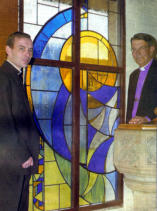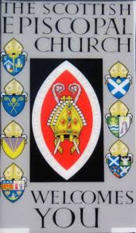

© St Peter’s Episcopal Church, Kirkcaldy 2023
St Peter’s Scottish Episcopal Church
With St Mary & St Leonard, Kinghorn Charity Nos: SCO10443
Townsend Place, Kirkcaldy, Fife
KY1 1HB
Tel: 01592 204208
Email: cnfraser@btinternet.com
Anniversary Window
This window was designed, constructed and installed by Eleanor
Pattinson, now Eleanor Porter, to mark the 25th anniversity of the
building of the present church. Rev John Penman and Bishop Michael
Henley presided over the blessing of the window at the celebration of St
Peter's day on 1 July 2001. The following is Eleanor's account of the
design.
The Seven Gifts of the Holy Spirit:
A new window for St Peter's Episcopal Church, Kirkcaldy
Then Peter said to them:" Repent, and let everyone of you be baptized in the name of Jesus Christ for the remission of sins; and you shall receive the
gift of the Holy Spirit". (Acts 2: 38) On hearing Peter's instructions on the day of Pentecost, three thousand people did just that. And in the two
thousand years since he said it millions more have continued to hear his instruction and be baptized.
It is appropriate then that St Peter's Church, Kirkcaldy - one of the many Churches dedicated in the name of this great man, has chosen to mark the
25th anniversary of its present building with a window to exalt and glorify its baptistery. Peter's words were instrumental for me in shaping the
direction of the design and theme of the new window. My idea was to create something that would aid those contemplating baptism to focus on the
gift of the Holy Spirit that Peter told us we would receive. Creating a visual design with something so ethereal as the nature of the Spirit as its main
theme was both a challenge and, paradoxically, made easier by the subject's intangible nature. Literal, figurative pictures illustrating Old and New
Testament stories and characters, do little to enhance modern churches such as St Peter's. Such windows were born out of previous centuries when
largely illiterate populations could rely on them as a sort of 'poor man's bible'. Indeed the existing stained glass window in St Peter's - Christ in
Majesty - is entirely symbolic and any attempt at literalism in a second window would have produced an inharmonious clash between the two. It was
therefore obvious to me from the start that the new window had to be abstract in design. But even though the window was to be abstract it still had
to have 'meaning'. A window that was just a puzzle to the onlooker would make no contribution to the heightening of Christian experience, indeed it
would probably do the opposite, thereby making the already mystifying and manifold concept of the Holy Spirit even more confusing and
bewildering! While it was never my intention to attempt the impossible and produce a window that depicted a definitive picture of the Gift of the
Holy Spirit, an image had to be found that went someway to illuminating the idea and creating something that would provoke further reflection and
contemplation. Researching possible directions, I decided to look back in history to how the Holy Spirit has been depicted in art through the ages.
Themes are obviously recurrent. In his book Signs and Symbols in Christian Art, George Ferguson writes: "The Holy Ghost is usually depicted as a
white dove ... In paintings of Pentecost the Holy Ghost appears in the form of rays of light or flames... Seven is the number of the Holy Spirit in
reference to the sevenfold gifts.' The 'sevenfold gifts' are only enumerated once in the Bible, in Isaiah 11: 2-3 where the prophet foresees and
describes the gifts which will be bestowed upon Jesus: And the Spirit of the Lord shall rest upon him, the spirit of wisdom and understanding, the
spirit of counsel and might, the spirit of knowledge and fear of the Lord and his delight shall be in the fear of the Lord. These are often referred to as
the gifts of Wisdom, Understanding, Counsel, Fortitude, Knowledge, Fear and Piety. By using the seven gifts as a foundation for the theme of the
window it was possible to combine the need for meaning with non-figurative design. But while Wisdom, Understanding and Knowledge are words
that are very much in everyday usage and are 'open' enough to spark multiple directions of thought when used as a starting point for contemplating
the Holy Spirit, Counsel, Fortitude, Piety and Fear were thought to be more problematic. Counsel and Fortitude are very much 'old' words; rarely
used in common speech, and Piety and Fear have become loaded terms that are now generally used in a negative sense.
It was a chance search on the Internet that produced a meaningful modern interpretation of the seven gifts. A Religious Education department at St
Philip Howard Catholic High School, West Sussex, had set their students the following interpretation to study on their online intranet page:
Wisdom, Understanding, Right Judgement, Courage, Knowledge, Reverence, Wonder and Awe. The reinterpretation of the four problematic words
was a sensitive up-dating which I felt was an appropriate starting point for anyone contemplating baptism in a modern Church in the 21st century.
The names of the seven gifts have been etched onto stylised flame shapes to symbolise the corning of the Holy Spirit at Pentecost: Suddenly there
came a sound from heaven as of a rushing mighty wind, and it filled all the house where they were sitting. And there appeared unto them cloven
tongues like as of Fire. And they were filled with the Holy Ghost. (Acts 2: 2-4) I intended that the 'flames' looked as if they are being swept across
and out of the window, caught in blue glass to symbolise the colour of heaven and sky. As Ferguson writes: "Blue, the colour of sky, symbolises
Heaven and heavenly love. It is the colour of truth, because blue always appears in the sky after the clouds are dispelled, suggesting the unveiling of
truth". The blue sweeps across the window from a series of yellow circles which overlap and are interrupted as they run through each other. The
circle as an eternal and never-ending shape represents God: "Who was in the beginning, is now, and ever shall be, world without end". The layers of
circles indicate depth and multi-layered meaning. In Renaissance painting yellow is the colour of the sun and is therefore used to symbolise divinity.
The last part of the design that was incorporated with definite meaning in mind were the small triangular prisms which cascade through the
intensely, busy vertical band which begins in the top right section and continues in to the bottom left. The equilateral triangle is the symbol of the
Holy Trinity: the very foundation of our faith. Hopefully, these prisms will sparkle and throw intense light far into the Church on sunny mornings.
Not every detail of the window is loaded with meaning, in fact some parts have no intended symbolism at all. It was never my intention to produce a
highly intellectual work that needed great explanation and I hope the symbolism that is there is simple enough for everyone to understand. I also
hope that it can be enjoyed as a straightforward burst of colour and shapes. And if you find yourself reading other meaning into it, please do. Don't
just be constrained by my ideas.
Eleanor Pattinson.





- News & Events 2005
- News & Events 2006
- News & Events 2007
- News & Events 2008
- News & Events 2009
- News & Events 2010
- News & Events 2011
- News & Events 2012
- News & Events 2013
- News & Events 2014
- News & Events 2015
- News & Events 2016
- News & Events 2017
- News & Events 2018
- News & Events 2019
- News & Events 2020
- News & Events 2021
- News & Events 2022
- News & Events 2023
- News & Events 2024
- News & Events 2025











